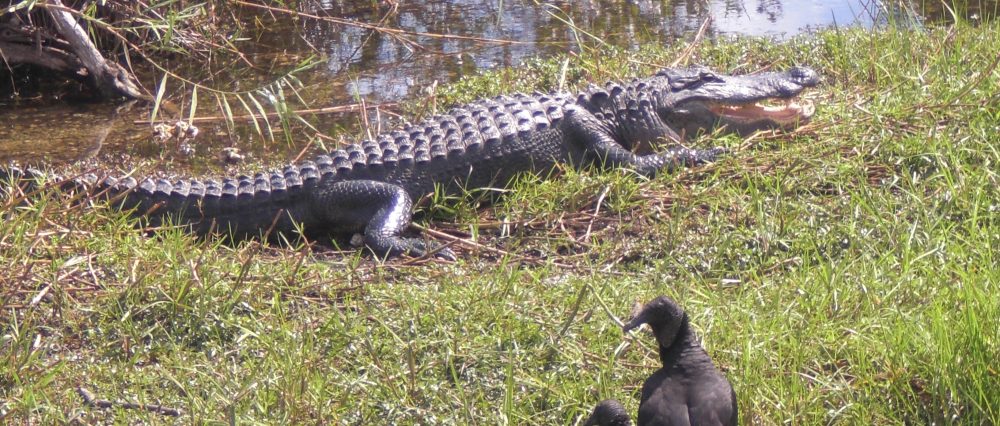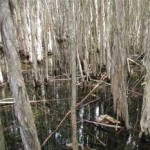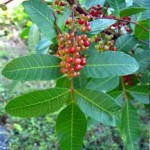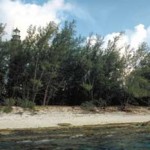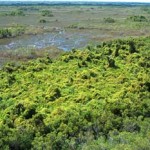The melaleuca is vanishing from Loxahatchee
By Olivia Balsinger
Throughout the warmer months, its cream-colored flowers offer a stark contrast to the green leaves, on its curvy branches.
But within the Everglades of South Florida, this Australian import, the melaleuca, does not belong.
The melaleuca, a tree originally from Australia and New Guinea that arrived in South Florida about a century ago, provides shelter but very little else in food or resources.
It is a pest, an invasive species resistant to fires and other threats.
Yet the Arthur R. Marshall Loxahatchee National Wildlife Preserve in Boynton Beach, Florida has wiped out 85
percent of its Melaleuca.
According to Lisa Jameson, an invasive species biologist at Loxahatchee, the success of the decrease in melaleuca is due to programs instilled by the park to control the main invasive species. While the plant originally covered about 94,000 acres of land within the Loxahatchee, Jameson said that it would likely cover less than 6,000 in the next year and a half.
Authorities are attempting to limit the spread of melaleuca by quarantining stands of trees, and applying varying herbicides, including melaleuca psyllid and melaleuca snout weevil, that kill seedlings. The maintenance control from melaleuca has been so successful that it now covers less than five percent of the area
“Since I arrived in 2008, we have been working on trying to eliminate or really minimizing the amount of invasive species by putting them under maintenance control,” said Jameson. “We work on each invasive individually until it is under control. Melaleuca has been a great success so far.”
Melaleuca, however, proves to be one of the more successful stories of invasive species within the Everglades.
Protecting the reserve is extremely critical right now because the U.S. Fish and Wildlife Service leases the land from the South Florida Water Management District. In order for Loxahatchee to keep the refuge and land, the four primary invasive species, melaleuca, Brazilian pepper, Australian pine and old world climbing fern, must be under maintaince control. The stipulation is that all four species must have less than one percent coverage by 2017 in order for the land to keep its ownership.
Jameson believes that perhaps the most difficult invasive plant to control will be the climbing fern because of its ease in spreading and taking over areas. It will be almost impossible to eliminate this plant as easily as the other three by 2017, said Jameson.
The treatments for eliminating old world climbing ferns in a refuge are different than those used in a forest. However “there is a lot of research going on right now to develop bio-control, though different chemicals that can kill spores in soil and also kill the plants,” said Jameson. “The park is trying different treatments with fire and drowning out the old world climbing fern.”
“Unless we nuke everything, we are scared we will not meet the 2017 deadline,” she continued. “But if we did that, there would be too many native dead plants, which really makes the issue of invasives a two-sided coin.”
Invasive species are the second biggest threat to biodiversity next to loss of habitat, according to Jameson, which is why so much time and effort has gone into their elimination. One of the main reasons as to why they can persist in habitats that are not their own is because they may not encounter natural enemies.
“Exotic plant species thrive in South Florida. Also, we are so mobile in this era, which is why nonnative species growth is accelerating at the rate it is going at,” she explained.
In fact, according to Larry Perez, a science communications interpreter at Everglades National Park, about 40 exotic species arrive each month on the shores of the United States.
“Some invasive plants and animals cool look beautiful. They could just be in the wrong place at the wrong time,” said Jameson.
One exotic species that has been a highlight of media attention and which many not be ordinarily categorized as beautiful is the Burmese python, which has been multiplying and may now number as high as 180,000 within South Florida.
One means of attempting to stop the spread of the invasive species is through legislation. For instance, federal laws now prohibit pythons from coming into the country to be sold as pets without given explicit permission.
Once they are here, their costs can be enormous. According to Jameson, about $5 billion annually is spent by the United States through taxes to try and tame the amount of native species. Out of this amount, $2 billion a years spent to keep the invasive species that have already spread more contained in certain areas.
“[Everyone in America] needs to be concerned with the invasive species problem in the country because it is all of [our] tax money,” said Jameson.
Jameson came to Loxahatchee in 2008, but she has held jobs with the National Parks Service that have taken her to all of the states and posts on both the east and west coast of the United States.
Jameson graduated with a comprehensive wildlife degree and then worked part-time for the federal forest service in timber management. She then went to work for park services and the Missouri Department of Conservation until becoming a permanent employee for the National Park Service 26 years ago.
“My interest in invasive species began about midway through my career,” Jameson said. “I had a really good teacher who was the national management specialist, and in her class I learned about integrated pest management issues, which included bats, birds and all pests regardless of if they were invasive or not.”
Jameson’s career was stimulated through education, and now she tries to make others aware of the problem of invasive species within the Everglades through the same measure. Education, according to Jameson, is one of the easiest and most beneficial ways to educate the public about the potential dangers associated with nonnative species.
Jameson once took a group of students into a forest where melaleuca trees had very much taken over the area.
“I stopped everybody and I said listen… and that’s what they heard—nothing,” explained Jameson. “None of the students could hear what used to be able to be heard…and that may likely have something to do with these invasives.”
Jameson also encourages everyone to learn what plant and animal species are native and what are nonnative. “If you choose to get an exotic pet, find out about its habitats, if it is compatible with the new environment. It is just important to educate yourself.”
“The best way to control and eventually stop the spread [of exotic species] is prevention,” said Jameson. “If we can prevent it now, we will not have the infestation later.”
(Four photographs of the invasive species courtesy of the University of Georgia Center for Invasive Species and Ecosystem Health)
